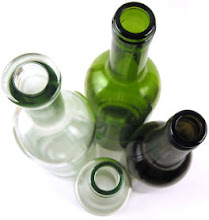Glass makes up a large component of household and industrial waste due to its weight and density. The glass component in municiple waste is usually made up of bottles, broken glassware, light bulbs and other items. Glass recycling uses less energy than manufacturing glass from sand, lime and soda. Every tonne of waste glass recycled into new items saves 315 kg of carbon dioxcide . Glass that is crushed and ready to be remelted is called cullet.
Glass Reuse
Reuse of glass containers is preferable to recycling according to the waste hierarchy. Refillable bottles are used extensively in many European countries, Canada and until relatively recently, in the United States. In Denmark 98% of bottles are refillable and 98% of those are returned by consumers. A similarly high number is reported in Canada. These systems are typically supported by container deposit laws and other regulations. In some developing nations like India and Brazil, the cost of new bottles often forces manufacturers to collect and refill old glass bottles for selling carbonated and other drinks.
Of the materials being recycled today, glass is still one of the most difficult to reuse. One of the major problems with glass recycling is the separation of clear and colored glass. To date, there have been very few applications for mixed glass. Glass made up only 6.3% of the total materials recycled in 1994. Of the total glass being recycled approximately 63% is clear glass used for remelting to produce more containers. There are few takers for refuse glass not presorted by color.
Waste glass has many uses. Used as an additive in clay, glass lowers the processing temperature and therefore, lowers the costs for producing tiles and bricks. The glass chemically bonds with the clay and makes the product stronger. Used as an additive in plastic, finely ground glass readily replaces the calcium carbonate filler already in use. The glass filler increases the strength and ductility of most plastics tested. When the ground glass was mixed with a ceramic it was inexpensively processed to form finished parts that don't require machining. The glass/ceramic composite material was twice as hard as regular glass. Ground glass was used as an abrasive for water jet cutting. In most applications it performed as well as the garnet normally used. The cost of the garnet is approximately $800 ton. The glass abrasive was produced from waste glass at approximately $10 ton. In sandblasting operations, ground glass, an amorphous silica, can safely replace silica sand, a crystalline silica, and a known carcinogen. There are many uses for ground waste glass, many applications can be found in the local community.
-i am leader pls group-


No comments:
Post a Comment